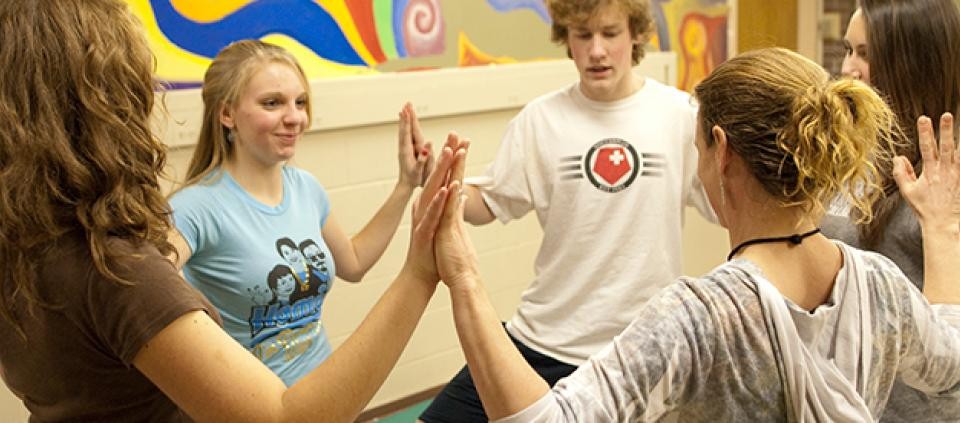Yoga in Schools Isn’t Just for Kids: How Teachers Benefit

by Jane Rosen
Two years before the end of my 36-year career as an educator, I started practicing yoga and sharing it with my fourth-grade class. In those two years, I saw the profound effects of yoga on my students’ learning, the emotional climate of my classroom, my interactions with students, my satisfaction with teaching, and my own health and well-being.
Teachers and students work under enormous pressure to perform on standardized achievement tests, whose outcomes can affect children’s futures and teachers’ evaluations, job security, and compensation. Nationwide, the curriculum has become test-driven, while many artistic and creative aspects adding enjoyment and engagement to the school experience have been eliminated.
Yoga is one path to a classroom where teachers and students can relax in the face of stress, and love themselves, each other, and their work a little more. As one teacher put it, “I’m glad the yoga class is on Wednesday. By then, I don’t like the children very much anymore. After yoga class, I like them again.” Teachers benefit most when they practice yoga alongside their students, coteach with a visiting yoga instructor, and integrate yoga-based games and activities into the school day.
After my retirement, I pursued yoga teacher training; I became a YogaKids teacher and teacher trainer and a Kripalu Yoga teacher. Now I deliver classes to children and teachers in Berkshire County, Massachusetts, schools with support from Kripalu’s Teaching for Diversity program, and mentor yoga teachers who are new to working with children. I also communicate with school administrators, support staff, parents, and community organizations to help them understand the value of yoga in school.
Here are some ways I’ve seen teachers impacted by having yoga in the classroom.
Receiving. Teachers can receive the benefits of yoga for themselves, e.g., improvements in strength, flexibility, balance, equanimity, calmness, and relaxation. Even teachers who have a yoga practice outside of school benefit from practicing with their students. The active practice of releasing tension and stress in yoga class gives teachers permission to relax fully and let go of what’s no longer serving them.
Breathing. The practice of conscious breathing provides a ready solution for many challenges during the school day. It doesn’t require special clothing or equipment, moving furniture, or very much time. A one-minute breathing break helps to improve the learning environment, and builds a skill that students can use in their own time. A breathing break improves posture, attention, and focus, and encourages mindful action. In a crisis, taking a moment to breathe together makes efforts to resolve a conflict more productive.
Traveling. Teachers are surprised to find that yoga can happen not just during a yoga class, but throughout the day. Integrating yoga tools into their lives turns them into “anywhere, anytime” yogis. They give themselves permission to practice yoga while teaching, in a meeting, on the playground, or as they transition from class to class.
Focusing. Balance poses can sharpen the powers of concentration. Teachers and students learn to direct their gaze, withdraw from distractions, and develop their stamina in maintaining a one-pointed focus.
Seeing with new eyes. Sharing a yoga practice with a class gives teachers a new perspective on their students as individuals and group members. In addition to knowing them as readers, writers, and problem solvers, teachers observe students as breathers and movers. They begin to see movement as a new and different way to practice the same skills of focus, concentration, listening, and following directions that are so important for academic tasks. One teacher became more aware of her own freedom to move about—while she and other teachers expected the students to sit still for long periods of time.
Adjusting the energy. Through the internal focus of yoga, teachers can build awareness of their energy and how it’s affected by times of the day, meals, interactions, interruptions, and both everyday and unusual stressors. From that internal awareness, they develop the ability to acknowledge and influence the energy of others. They learn how to use conscious breath and movement to adjust the energy level in the room, from settling the frenetic energy that students bring in from the playground to energizing a group in a mid-afternoon slump.
Integrating. Teachers can use movement to echo and reinforce concepts taught in every subject—for example, animal movements for a study of animal life or anatomy, shapes made with the body to portray geometric figures or trigonometric functions, counting or calculating along with repetitive movements, or using yoga poses to act out the movements of characters in a story.
Staying balanced. Yoga helps teachers explore their ability to control their responses to stressful situations. They often cannot control the situation itself or individual players in it, but they can remain calm, slow down their responses, make better choices, feel empowered, and take clear action. They move from feeling hurt and victimized to feeling more capable and confident, using breath and movement to reduce the effects of chronic stress.
Our classrooms need the pleasure-giving, community-building, and life-enhancing tools of yoga. When teachers thrive, so do their students.
Jane Rosen holds a PhD in educational psychology, and retired in 2001 after 36 years as an elementary classroom teacher and principal. She is a 500-hour Kripalu Yoga teacher with additional training from YogaKids, Yoga Ed, Radiant Child Yoga, Ageless Grace for KIDZ, and Kripalu Yoga in the Schools.